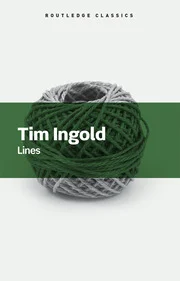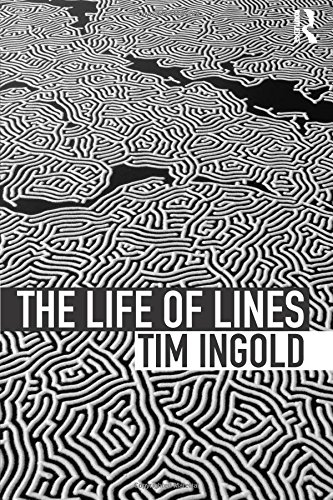A while ago when reporting on a lecture I went to given by Tim Ingold, I suggested that his two books on line were an essential read. ‘Lines: A Brief History’ and ‘The Life of Lines’ both open out our thinking about drawing into the theatre of life itself and help those of us that draw to invest our drawings with a wide range of possible meanings. I also stated at the time that I would provide a summary of the two books and give an indication of possible ways to use them.
Ingold, T. (2016) Lines a Brief History London: Routledge
In 'Lines a Brief History' Ingold points out that a wide range of human activities including walking, weaving, observing, storytelling, singing, drawing and writing all need to proceed in linear directions and that embedded into the very language that we talk about these things are line metaphors. For instance in order to tell a story we move events from A to B, we stretch out our sentences into lines of text. As we walk we create lines, both physically, (Richard Long makes lines by walking through grass, but so do we all.) as well as metaphorically. The old idea of the Wyrd for instance uses the image of an invisible line that is connected to you from birth, (a sort of ghost of the umbilical cord), as you move through life this line entangles itself around all the people and things you interact with, eventually weaving a cloth that is literally the tapestry of your life. In this book Tim Ingold imagines a world in which everything is interwoven or interconnected by lines and lays the foundations for a completely new discipline: the anthropological archaeology of the line.
Ingold is very much a polymath and uses a wide range of sources to illustrate his points, including archaeology, classical studies, art history, linguistics, psychology, musicology, philosophy and drawing.
Ingold's book is a great help when writing artist's positioning statements. He uses visual metaphors to demonstrate that you can take a concept and use it across many different disciplines to illuminate the way that human beings think, and reminds us that thinking itself begins with embodied experiences. For instance the idea of the 'Wyrd' begins in the actual experience of one human being being linked to another by a 'line' or umbilical cord. He points out that one of the earliest uses of vegetable fibres was to twist them together to create lines, lines that we call threads, strings or ropes. As we began to use these lines of thread, the various uses we put them to allowed us to think about different things. This is an extended mind theory which suggests that we use the stuff of the world to develop ideas or trains of thought. Threads allow us to weave ideas together, strings to tie them together and rope to scale up and over them. For instance lets say we are fishing using a line and rod, we might develop all sorts of ideas that begin with the idea of a connection between one thing and another. A line physically connects two things together, but the way it does varies. Alfred Gell introduced us to the ‘spring-hook fishing trap’ from Guyana. It consists of a fishing line linked to a bent tree branch, which is held in place by an easily displaced notch, one that the fish in effect 'trips' as it pulls on the line. When the fish bites down on the bait, its mouth is caught on the hook and in its struggle to get away it un-notches the held down branch, which springs upright, its violent release throwing the fish up into the air, leaving it dangling. In Guyana it is known as ‘the trap that turns fish into fruit’. One minute the fish is swimming and whoosh! The next minute it is hanging like fruit from a tree. As a metaphor for the harsh often sudden confrontation of death within life it is very powerful, just as easily read by Western European art audiences as fishermen from Guyana. Alfred Gell is another anthropologist which I presume is why he is also read extensively by artists. Anthropologists watch how a society thinks and as outside observers often without a good knowledge of that society's verbal language, they will often see how things are used by a society to think with, much easier than that society itself. I.e. they are in a very good position to observe the extended mind at work and the extended mind theory is as far as I'm concerned essential to an understanding of how art works. What you make allows your audience to 'see' an idea, not just to think about a concept in the head, but to physically know it. Most of Ingold's references rely on the extended mind theory and for someone making physical objects that have ideas embedded within them, his insights can be a real help, especially when trying to find the right words with which to explain how something you have made relates to life's experiences.
Ruskin points out that "the foam is not cruel, neither does it crawl. The state of mind which attributes to it these characters of a living creature is one in which reason is unhinged by grief." He goes on to state; "Now, so long as we see that the feeling is true, we pardon, or are even pleased by, the confessed fallacy of sight, which it induces: we are pleased, for instance, with those lines ... above quoted, not because they fallaciously describe foam, but because they faithfully describe sorrow". (From Modern Painters)
In some ways Ingold's text could be critiqued in a similar way, it works at its best when the
analogies he uses ring true.
See also:
Tim Ingold: On not knowing and paying attention
Tim Ingold's keynote speech for the art and materiality conference
The exhibition 'lines a brief history'


No comments:
Post a Comment